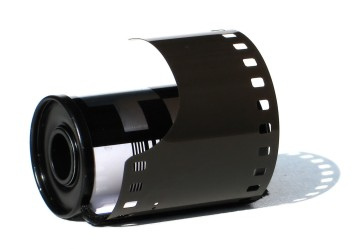Sommario
L'obiettivo - l'otturatore - il diaframma - indici di esposizione - mirino fotocamera - l'esposimetro - il telemetro - la pellicola - regola per una esposizione perfetta - La distanza iperfocale - La messa a fuoco all'infinito - Regole per utilizzare l'esposimetro analogico - Soggetti in movimento - La pellicola pancromatica - Fotografia con teleobiettivi - Consigli per la fotografia a colori - Misura dell'esposizione
- ITA -
Componente fondamentale, per quanto riguarda la fotografia analogica, è senz'altro la pellicola. Vediamo come viene prodotta.
La pellicola è costituita da un supporto trasparente dove si trova un sottilissimo strato di bromuro d'argento. Quest'ultimo molto sensibile alla luce deve esser tenuto in un'apposito contenitore, in modo tale da non esser danneggiato durante il normale trasporto.
Una volta inserito nella fotocamera può essere usato ad ogni scatto, restituendo così le nostre immagini preferite.
Lo strato di cui abbiamo parlato è detto "emulsione" e viene preparato a vari gradi di sensibilità. Ciò è possibile cercando di governare la quantità di ologenuro di argento al suo interno.
Tale quantità viene indicata in DIN o ASA.
Ciò cosa vuol dire:
Un aumento di 3° DIN o un raddoppio del numero ASA corrisponde al raddoppio della sensibilità.
Ciò significa che a parità di luce più è alta la sensibilità e tanto più breve dovrà essere l'esposizione.
E' importante, dunque, indicare all'esposimetro, interno od esterno alla fotocamera, la sensibilità della pellicola, in modo da ottenere una lettura adeguata per quanto riguarda tempi ed aperture del diaframma.
E' molto importante tener conto della data di scadenza delle pellicole acquistate, in quanto la sensibilità dell'emulsione dopo un certo periodo di tempo tende a diminuire.
Le pellicole possono essere sia in bianco e nero che a colori.
Quest'ultime possono essere i due tipi:
- Pellicola invertibile: Fotogramma positivo in diapositiva, i colori saranno quelli reali ma per poterla visionare si avrà bisogno di un proiettore.
- Pellicola negativa: Si ha bisogno di un procedimento di stampa per poterle visionare in modo accurato.
Infine:
- Pellicole invertibili: Adatte alla luce notturna, diurna ed artificiale.
- ENG -

Fundamental component, regarding the analog photography, is certainly the film. Let's see how it is produced.
The film is formed by a transparent support where there is a thin layer of silver bromide. The latter is very sensitive to light must be kept in a special container, in such a way as not to be damaged during normal transport.
Once inserted in the camera can be used with every shot, thus returning our favorite images.
The layer that we talked about is called "emulsion" and is prepared to varying degrees of sensitivity. This is possible by trying to govern the amount of ologenuro of silver on the inside.
This amounts being is indicated in DIN or ASA.
This is what it means:
An increase of 3 ° DIN or ASA doubling the number corresponds to a doubling of sensitivity.
This means that the same light the higher the sensitivity and the shorter will be the exposure.
It 'important, therefore, indicate all'esposimetro, internal or external to the camera, the sensitivity of the film, in order to obtain a proper reading as regards time and aperture openings.
E 'is very important to take into account the date of expiry of the films purchased, as the sensitivity of the emulsion after a certain period of time tends to decrease.
The films can be either black and white or color.
The latter may be the two types:
- Film invertible: Frame positive slide, the colors will be the real ones but to be able to view you will need a projector.
- Negative film: It needs a printing process to view them in an accurate manner.
Finally:
- Reversal Films: Suitable for the night light, daylight and artificial light.









